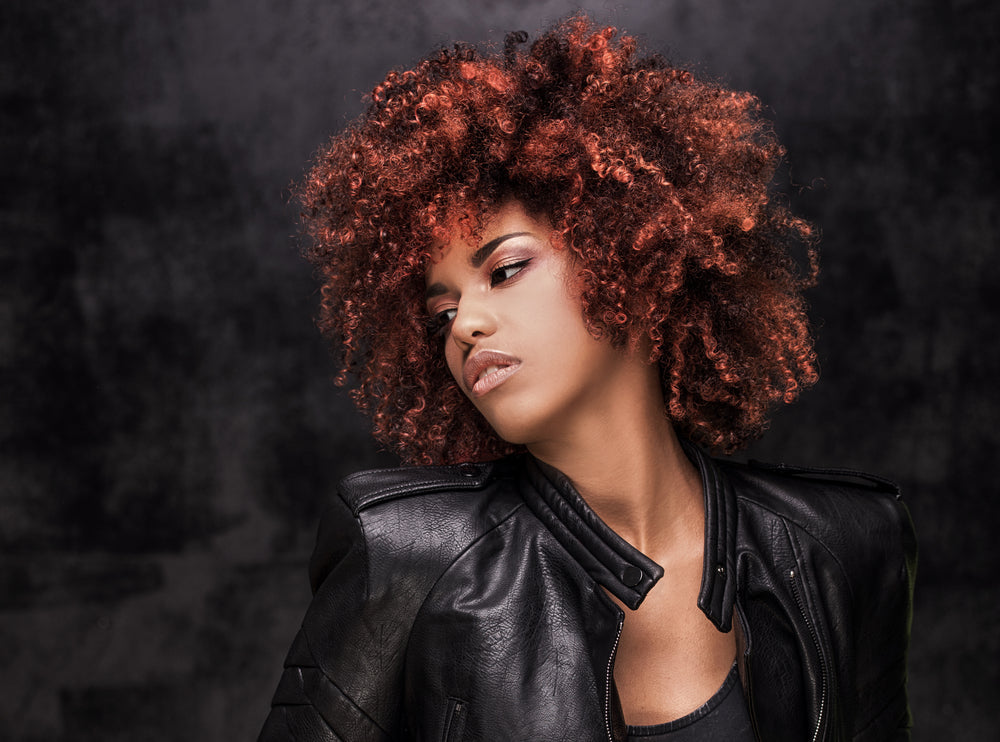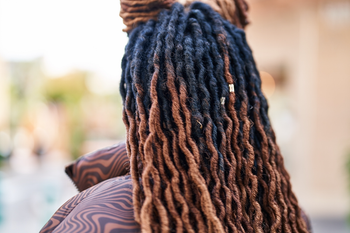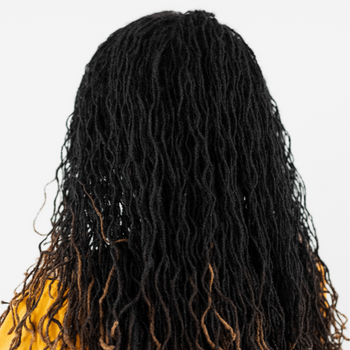

Does dyeing your textured hair damage it? Around 70% of American women color their hair regularly with permanent dyes. While common, this beauty practice has hidden risks that deserve attention.
Permanent hair dye uses ammonia, hydrogen peroxide, and PPD to penetrate your hair shaft, altering its protein structure. This can weaken strands, reduce thickness, and increase roughness. Bleaching particularly affects hair softness and strength by changing porosity and elasticity.
Studies link hair dye chemicals to health concerns, with black women facing 45% higher breast cancer risk from regular use. However, safe coloring options exist.
This article explains what happens during the dyeing process and how to prevent damage when coloring textured hair while still achieving your desired look.
Table of Contents
What Happens to Your Textured Hair When You Dye It
Your textured hair undergoes significant chemical changes during the coloring process. Understanding these transformations helps explain why some coloring methods impact hair health more than others.
Types of Hair Dye: Temporary, Semi-Permanent, Permanent
Hair coloring products fall into distinct categories based on how they interact with your hair structure and how long they last.
Temporary hair dyes coat only the outside of the hair shaft without penetrating the cuticle. These products use larger color molecules that simply wash away after one shampoo. Think of them as makeup for your hair—they sit on the surface and rinse off completely.
Semi-permanent dyes contain smaller molecules that partially penetrate the outermost layers of the hair shaft. Because they don't contain ammonia or peroxide, they cause minimal damage compared to permanent options. These colors typically last through 4-12 shampoos. Such dyes provide a gentle way to enhance your natural color or experiment with new shades without long-term commitment.
Permanent hair colors create lasting change through a complex chemical process. Once applied, they fundamentally alter your hair structure by penetrating deep into the cortex. Unlike other options, permanent dyes cannot be washed out—they remain until your hair grows out.
How Dye Penetrates the Hair Shaft
The science behind permanent hair color involves an intricate chemical reaction. First, alkaline ingredients (usually ammonia) open the hair cuticle—your hair's protective outer layer. This raises the pH level, causing the hair to swell and creating pathways into the inner structure.
Once the cuticle is lifted, hydrogen peroxide enters and serves two crucial functions: it breaks down your natural hair pigment (melanin) and activates the dye precursors. These small, colorless molecules penetrate deep into the cortex, the middle layer of your hair.
Inside the cortex, these dye molecules undergo oxidation, combining to form larger color molecules. These new pigments become trapped within your hair shaft because they're now too large to escape through the cuticle, essentially locking in the color.
Why Bleach is More Damaging Than Dye
Bleaching works through a more aggressive version of the oxidation process. Furthermore, unlike regular coloring that both removes and deposits pigment, bleach focuses solely on stripping away your natural color.
The bleaching process uses higher concentrations of hydrogen peroxide along with persulfate salts, which aggressively break down melanin in your hair. This intense chemical reaction continues working until it is completely stopped, potentially disintegrating the hair shaft if left unchecked.
Consequently, bleached hair becomes significantly drier, more brittle, and prone to tangling than textured hair treated with regular dye. The oxidation process drastically reduces hair elasticity, leading to a much higher chance of breakage. For this reason, professional application becomes especially important when bleaching your hair.
Is Hair Dye Bad for Your textured Hair? The Real Damage Explained
The science is clear: hair coloring causes measurable structural damage at the molecular level. Studies show even a single dyeing session inflicts noticeable harm, with damage escalating after three or more treatments.
Breakdown of Hair Proteins and Lipids
Chemical dyes fundamentally alter your textured hair's composition. The alkaline agents in permanent dyes break down protein bonds within the hair shaft, deteriorating its structural integrity. Similarly, your hair's natural lipids—essential for protection and moisture—get stripped away during coloring. These lipids typically seal the cuticle, preventing excessive moisture loss. Without them, your strands become susceptible to dehydration, appearing dull and feeling coarse.
Research reveals that synthetic and natural dyes (including henna) can trigger protein loss, making hair noticeably weaker and more fragile. This protein deterioration continues with each subsequent coloring session.
Increased Porosity and Brittleness
After coloring, your hair's porosity—its ability to absorb and retain moisture—changes dramatically. Initially, this increased porosity might make your hair look more voluminous since the raised cuticle creates texture. Nevertheless, the long-term effects are concerning.
Highly porous hair struggles to maintain appropriate moisture levels. The cuticle, now damaged and raised rather than smooth and flat, allows moisture to escape too easily. As a result, color fades quickly, and strands become increasingly brittle and prone to breakage.
According to hair experts, once you've altered your hair's porosity through coloring, it's nearly impossible to restore it to its original state without cutting off the treated portion.
Heat Sensitivity and Texture Changes
Colored hair becomes substantially more vulnerable to heat damage. The internal structural changes make dyed strands less capable of withstanding thermal styling tools. Indeed, heat from blow dryers, straighteners, or curling irons can further compromise already weakened hair, accelerating breakage.
Beyond damage, you'll likely notice significant texture changes after coloring. Many people find their hair feels rougher, coarser, and more difficult to manage. Throughout time, as you continue coloring, these textural changes intensify, potentially resulting in hair that's permanently altered in both feel and behavior.
Side Effects of Hair Dye Beyond the Hair
While hair damage is concerning, the side effects of hair dye extend far beyond split ends. Chemical components in coloring products can affect your overall health in several unexpected ways.
Scalp Irritation and Allergic Reactions
Hair dyes frequently trigger adverse skin reactions due to their chemical composition. Between 38-50% of people who color their hair report experiencing allergic reactions. Para-phenylenediamine (PPD), present in most permanent dyes, ranks among the most common allergens.
Reactions range from mild contact dermatitis to severe hypersensitivity. Symptoms typically appear within 48 hours and include redness, burning sensations, and itchy skin around the scalp, face or neck. Moreover, severe cases may progress to anaphylaxis—a potentially life-threatening condition characterized by facial swelling, breathing difficulties, and even unconsciousness.
Hormonal Disruption and Endocrine Concerns
Hair coloring products contain several ingredients classified as endocrine disruptors that can interfere with your hormone systems. Resorcinol, a common dye component, has been shown to disrupt thyroid hormone synthesis in laboratory studies. Although lower consumer exposure likely poses minimal risk, regular application merits consideration.
First-time mothers face additional concerns. Research indicates that chemicals in hair dyes might impact maternal hormone levels, potentially affecting fetal development. A Rutgers study found that hair dyes, bleaches, relaxers, and mousses were specifically associated with lower levels of sex steroid hormones, which play crucial roles in maintaining pregnancy.
Cancer Risk: What Studies Say
Studies examining cancer links have yielded mixed but concerning results. Women using permanent hair dye showed a 9% increased breast cancer risk, with black women experiencing a substantially higher 60% increased risk. Similarly, chemical hair straighteners were associated with a 30% higher breast cancer risk.
Occupational exposure presents even greater concerns. The International Agency for Research on Cancer classifies workplace exposure to hairdresser chemicals as "probably carcinogenic to humans". Research demonstrates that professionals working with hair dyes for over 10 years face nearly twice the bladder cancer risk.
Although evidence remains inconclusive about other cancer types, some studies suggest associations between hair dye use and certain ovarian cancers.
How to Prevent Damage when Coloring textured Hair
Coloring your textured hair without causing damage requires strategic choices and preventive measures. Even as chemical dyes alter your hair structure, you can minimize potential harm with these proven techniques.
Choose the Right Type of Dye for Your textured Hair
The gentler the coloring method, the less damage you'll experience. Temporary and semi-permanent dyes cause minimal structural changes to your hair shaft as they don't contain harsh chemicals like ammonia or high levels of peroxide. In contrast, permanent dyes and bleach products penetrate deeply, creating lasting damage. For major color transitions, consider consulting a professional who can assess your hair's condition and recommend appropriate products.
Do a Patch Test Before Every Application
Patch testing is essential before applying any hair color product—even your regular brand. This simple safety measure helps prevent allergic reactions, which can range from mild irritation to severe anaphylaxis. Apply a small amount of the dye solution behind your ear or on your inner elbow and leave it for 48 hours. If you develop redness, swelling, or itching, avoid using the product entirely. This precaution becomes particularly important as allergies can develop suddenly, even to products you've used safely before.
Use Sulfate-Free and Color-Safe Products
Standard shampoos containing sulfates act as powerful detergents that strip away color molecules alongside dirt and oil. To extend your color's vibrancy, switch to sulfate-free formulations specifically designed for colored hair. These gentler cleansers preserve your hair's protective lipid layer while maintaining color integrity. Look for ingredients like sunflower seed extract, which protects against UV damage, and hydrolyzed quinoa, which helps lock in pigment.
Deep Condition Regularly
Colored hair requires extra moisture to combat increased porosity. Deep conditioning treatments temporarily seal split ends and strengthen strands to prevent future damage. Match your conditioning regimen to your textured hair's specific needs:
For dry but healthy hair: Use protein-free conditioners weekly
For damaged hair: Apply high-protein treatments monthly, alternating with moisturizing masks
Limit Heat Styling and Sun Exposure
Heat tools accelerate color fading by further damaging already compromised hair structures. Whenever possible, air-dry your hair or wait until it's partially dry before blow-drying. Always apply heat protectant products before styling. Additionally, UV rays can bleach artificial color and break down hair proteins. Protect your hair outdoors with hats or UV-protective products to prevent sun-induced color changes.
Conclusion
Hair dyeing presents a balance between achieving the desired color and maintaining textured hair health. While permanent dyes offer lasting results, they can damage hair structure over time. Being informed about coloring is crucial for long-term hair wellness. Consider gentler options like semi-permanent dyes or space out permanent treatments while following proper aftercare. Hair coloring doesn't need to be abandoned - approach it thoughtfully rather than routinely. Many successfully maintain colored hair through informed choices and consistent care.
Frequently Asked Questions
Is hair dye permanently damaging to your hair?
While hair dye does cause some damage, it's not necessarily permanent. The treated hair will remain altered, but new growth will be healthy. The extent of damage depends on factors like dye type, frequency of coloring, and individual hair characteristics.
What are the health risks associated with hair dyeing?
Hair dyeing can lead to scalp irritation, allergic reactions, and, in some cases, may be linked to an increased risk of certain cancers. It's important to do a patch test before application and be aware of potential long-term health effects.
Are there any hair coloring methods that don't cause damage?
While all coloring methods affect hair to some degree, semi-permanent dyes and natural options like henna tend to be less damaging. These alternatives deposit color on the hair's surface without significantly altering its structure.
How can I minimize damage when dyeing my hair?
To reduce damage, choose the right type of dye for your hair, use sulfate-free and color-safe products, deep condition regularly, and limit heat styling and sun exposure. It's also advisable to space out your coloring sessions.
Does professional hair coloring cause less damage than at-home treatments?
Professional coloring can often be less damaging as stylists are trained to assess your hair's condition, choose appropriate products, and use techniques that minimize harm. However, the frequency of coloring and the products used still play a significant role in overall hair health.






